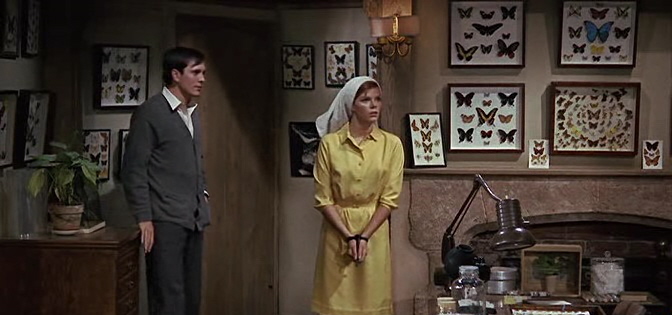The Collector (1965)
You said I was the most exotic flower
John Fowles’ The Collector at first appears to be a simplistic book but on analysis contains many complex themes that are all instrinsically tied together, symbollically representing the human mind. It’s visual representation on film is at once as disturbingly beautiful as the written word.
The story explores the external and internal worlds, addressing the way in which the human mind effects the human situation. Frederick, the protagonist, is at once bound to the internal world, confining himself to his own home physically as well as the home of his mind. Both his physical and mental worlds are isolated which leads to his ‘collection’.
On the one hand isolated beauty and a confined life is symbolised by his immense butterfly collection. In killing the butterflies for display he takes not only the literal conscious life but elimates the concept of flight of butterflies, making them at once helplessly immobile. They are removed from the external outside world in favour of glass screens and wooden frames, being reduced to hopelessly pitiful creatures. Frederick captures their beauty, stealing it from the natural world in order to selfishly contain this beauty for his own pleasure.

In the same way, Miranda becomes another butterfly in Frederick’s collection, being kidnapped and trapped in a cellar to the side of his house. She too is taken from the outside living world of light and, in her case, walking motion, becoming literally bound by rope as well as metaphorically bound by his surveillance. She is the final and ultimate butterfly that he has been pursuing, following her flightly freedom before trapping her too in his net.
When Frederick shows Miranda his butterfly collection she is at once appalled but fascinated by the countless creatures that line the walls, asking him to ‘look at all the living beauty [he has] killed’. This intriguing idea of attempting to preserve and capture beauty is reimagined in Miranda who becomes locked in a physical and mental battle with Frederick’s desire. He becomes obsessed with her, generating a fantasy in which they are the two lovers of Shakespeare’s The Tempest (he assumes the disguise of ‘Ferdinand’).
Whilst it is obvious to the reader and viewer that love can never connect the two, Frederick sees in Miranda the rarest butterfly of all his collection, the ultimate beautiful specimen. She becomes something to fill the isolated hole in his life and someone in whom he can share his collection. Ironically she is his only connection to the outside world, later educating him on literary and artistic works. However, in his attempts to bring together the external and internal worlds, Miranda’s metaphorical suffocation and her removal from nature’s light leads to her death. Just like the butterflies she becomes another beautiful creature captured and killed.
The film relies heavily on silences and pauses, emphasising the void in Frederick’s life and his separation from normal human interaction and response. He is unable to communicate with Miranda (or indeed anyone else) which shows how he is predominantly internal, living purely from his mind, creating elaborate fantasies in which the physical world cannot fulfill. He is ignorant to the actual meaning of beauty, unable to comprehend that it cannot be physically captured but must be appreciated in its living form. And just as Miranda says ‘everything here is death. is that what you love: death?’. In his fear of losing beauty forever he longs to possess it, intimately and alone; he becomes ‘the collector’.
What inspired me: The way in which the novel and film alike are approached from Frederick’s point-of-view, generating a bizarrely pitiful criminal in the protagonist. His blurring of the external and internal worlds are quite tragic becoming disturbingly intriguing just as his butterfly collection is disturbingly beautiful. Writing from the point-of-view of an unstable mind seems to produce the most interesting of works.
Originally published 25th April 2013
